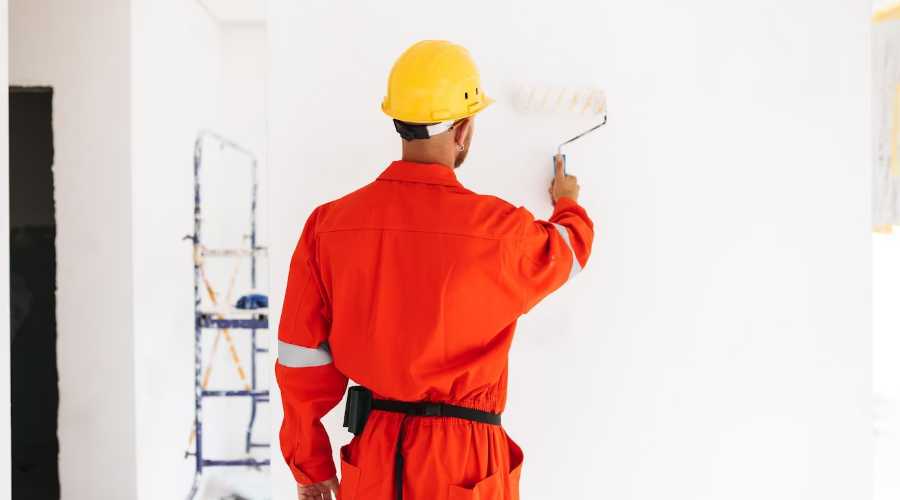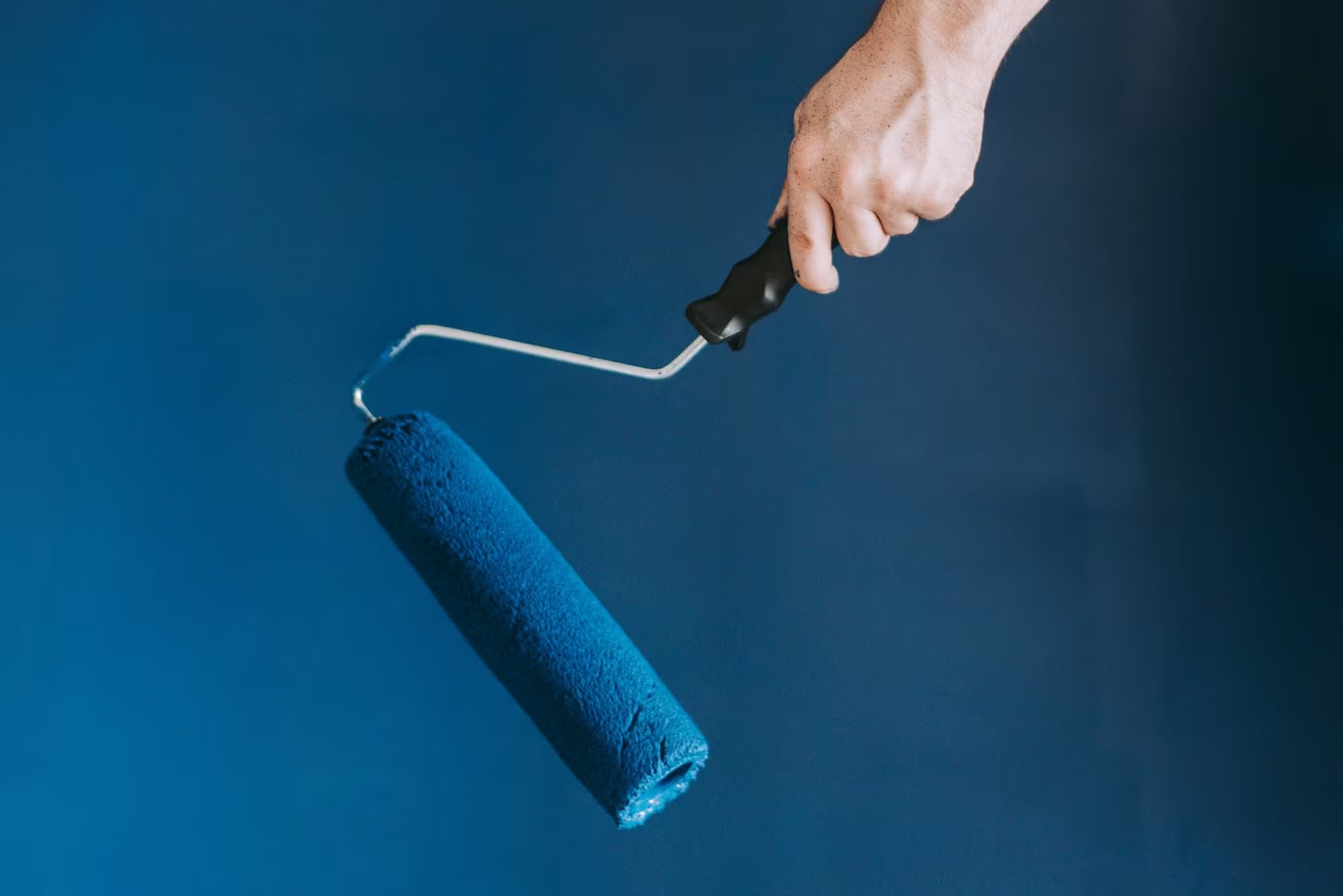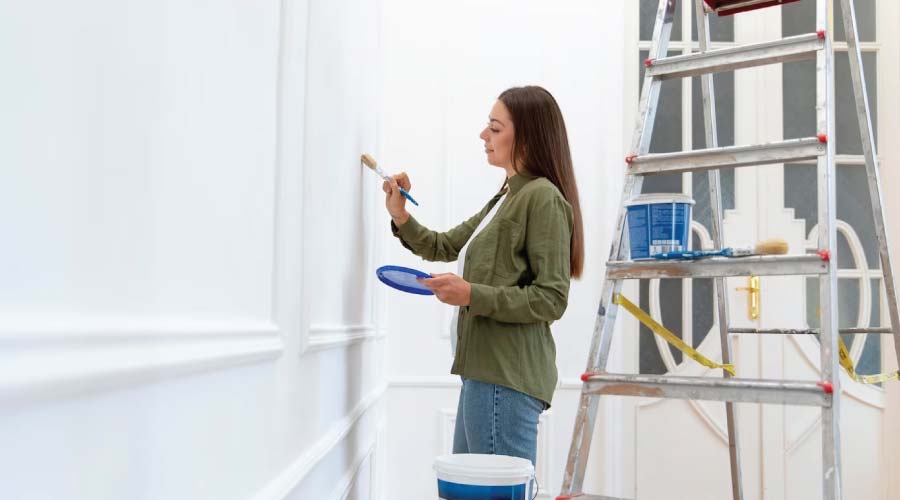Menu

Are you considering taking on a DIY house painting project? Painting your home can be a rewarding and cost-effective way to give it a fresh look. However, following the dos and don’ts of DIY house painting are crucial to ensure professional-looking results and avoid common pitfalls. In this comprehensive guide, we’ll provide valuable insights shared by experienced house painters in Milford, CT, to help you achieve stunning results and avoid costly mistakes.
Avoiding common mistakes in DIY house painting to ensure professional results is essential. Professional house painters in Milford, CT, emphasize the following don’ts to help you achieve the best possible outcome:
Regarding house painters in Milford, CT, ensuring painting safety is paramount. Let’s delve deeper into why painting safety should be a top priority:
Painting involves using various chemicals and substances that can be harmful if not handled properly. Volatile organic compounds (VOCs) in paints and solvents can release toxic fumes, leading to respiratory issues and allergies. By prioritizing painting safety, you minimize the risk of health problems associated with exposure to these hazardous substances.
Poor indoor air quality can significantly impact your overall well-being, especially when painting your home in Milford, CT. House painters in Milford, CT, know that toxic fumes and odors can linger in the air, adversely affecting the air quality inside your home. To ensure a healthier indoor environment during the painting process, it is essential to implement painting safety measures recommended by professional house painters in Milford, CT. These measures include proper ventilation and the use of low-VOC or zero-VOC paints.
Certain paints and chemicals can cause skin irritation and allergies upon contact. Taking necessary precautions, such as wearing protective gloves and clothing, reduces the risk of skin-related issues. Professional house painters in Milford, CT, prioritize safety measures to protect their skin and the well-being of their clients.
Inhaling paint fumes and dust particles can lead to respiratory problems, especially for individuals with pre-existing respiratory conditions like asthma. By implementing proper ventilation techniques, wearing masks, and utilizing dust control measures, painting safety ensures that the air you breathe remains free from harmful particles.
Some paints and solvents used by house painters in Milford, CT, are highly flammable, making it crucial to prioritize safety. Without proper safety measures, the risk of fire accidents in homes can increase significantly. To mitigate this risk, it is imperative to adhere to painting safety guidelines recommended by professional house painters in Milford, CT.
Selecting the right house painters in Milford, CT, is crucial for a successful and safe painting project. Here are some key considerations when choosing reliable professionals:
Look for house painters in Milford, CT, with a proven track record and substantial experience in the industry. Experienced house painters in Milford, CT, are familiar with painting safety protocols and have the expertise to handle various challenges that may arise during the project.
Ensure that the house painters in Milford, CT, you hire are properly licensed and certified to perform painting services. Valid licenses indicate that they have met the required standards and regulations set by local authorities.
Verify that the painting company has comprehensive liability insurance coverage. This protects you and the house painters in Milford, CT, in case of any accidents, injuries, or property damages during the project.
Research the painting company’s reputation by reading customer reviews and testimonials. Positive feedback from previous clients indicates their professionalism, reliability, and commitment to painting safety.
Inquire about the safety training provided to the painting team. Reliable house painters in Milford, CT, prioritize the well-being of their workers and have established safety protocols to ensure a safe working environment.
Assess the knowledge of house painters in Milford, CT, different paints, and materials. Professional house painters in Milford, CT, who are well-versed in the characteristics and proper usage of various paints, can guide you in making informed decisions for your project.

Implementing the following painting safety precautions, as advised by house painters in Milford, CT, is vital to safeguard your well-being during the painting process:
Proper ventilation, especially during painting projects handled by house painters in Milford, CT, is essential to maintain a healthy and safe environment. To achieve adequate ventilation, it is recommended to implement the following measures, as suggested by professional house painters in Milford, CT:
Before starting the painting process, open windows and doors to allow fresh air to circulate and fumes to disperse. This helps prevent the accumulation of harmful vapors and promotes a healthier painting environment.
Supplement natural ventilation using fans or exhaust systems. Position fans strategically to create a cross breeze that aids in drawing out fumes from the painting area. Exhaust systems can effectively remove airborne particles and maintain air quality.
Place box fans strategically to pull air out of the room, promoting better air circulation. Position the fans near windows or doors to facilitate the movement of air and aid in the ventilation process.
Plan your painting schedule for natural airflow. Choose cooler times of the day or when outdoor winds are stronger, as this can enhance ventilation and help dissipate fumes more effectively.
Creating negative air pressure can be beneficial in situations involving toxic fumes or chemicals. This involves using exhaust fans to remove air from the painting area, effectively pulling in fresh air from other house parts.
Using the appropriate personal protective equipment (PPE) is crucial to safeguard your health and well-being while painting. Consider the following protective gear:
Wear nitrile or latex gloves to protect your hands from direct contact with chemicals, irritants, or solvents in paints. Gloves act as a barrier, preventing skin absorption and reducing the risk of dermatological issues.
Choose masks or respirators specifically designed for painting projects. These respiratory protective devices filter airborne particles, including dust, paint droplets, and volatile organic compounds (VOCs). Look for masks labeled N95 or higher for efficient filtration.
Wear goggles or safety glasses to protect your eyes from paint splatters, debris, or chemical splashes. These protective eyewear options provide a barrier, reducing the risk of eye irritation or injury during the painting process.
Wear long-sleeved shirts, long pants, and coveralls made of durable materials to protect your skin from direct contact with paint and chemicals. This prevents potential skin irritation and exposure to hazardous substances.
If your home in Milford, CT, was constructed before 1978, it may contain lead-based paint. Take the necessary precautions to ensure lead paint awareness and safe removal:
Hire professionals skilled in paint testing to assess your home’s surfaces. They will conduct thorough tests to determine the presence of lead-based paint. Testing is crucial as lead exposure can lead to severe health issues, especially for children and pregnant women.
If lead-based paint is detected, consult certified professionals experienced in lead paint removal. These experts have the knowledge and equipment to safely remove lead paint, minimizing the risk of contamination during the process.
During lead paint removal, strict containment measures should be implemented to prevent the spread of lead dust. Professionals will use plastic sheeting, negative air pressure systems, and specialized equipment to contain the work area. Additionally, they will follow proper disposal procedures for lead-contaminated materials to adhere to environmental regulations.
Proper surface preparation sets the foundation for a successful paint job while reducing health risks associated with dust particles. Follow these surface preparation guidelines:
Thoroughly clean the surfaces to be painted using a mild detergent solution. Remove dirt, grease, grime, and any existing loose paint. Cleaning ensures better paint adhesion and reduces the risk of contamination during the painting process.
Smooth rough surfaces and remove any remaining loose paint by sanding. Use sandpaper with appropriate grit to achieve a smooth finish. However, be cautious with lead-based paint, as sanding can generate lead dust. Refer to lead-safe practices or consult professionals for guidance.
Apply a suitable primer to the prepared surfaces. Primers enhance paint adhesion, improve coverage, and help create a uniform finish. This step ensures the paint adheres properly, reducing the chances of peeling or blistering.
Implement dust control measures during surface preparation to minimize the inhalation of dust particles. Use a dust mask, and consider using a dust containment system or a vacuum equipped with a HEPA filter to capture airborne particles.
Proper handling and storage of paints and chemicals are crucial to prevent accidents and maintain a safe environment. Follow these guidelines:
Familiarize yourself with the manufacturer’s instructions and safety data sheets (SDS) for each paint and chemical product you use. Understand the recommended handling procedures, storage conditions, and potential hazards associated with the products.
Store paints and chemicals out of the reach of children and pets. Place them in locked cabinets or high shelves to prevent accidental ingestion or exposure.
Avoid mixing different paints or chemicals unless explicitly directed by the manufacturer. Mixing incompatible products can result in hazardous reactions, release toxic fumes, or compromise the quality of the paint.
Ensure paint cans and chemical containers are tightly sealed after use. This prevents leakage and preserves the quality of the products. Consider using plastic bags or wrap to create an additional seal before closing the lids.
Responsibly dispose of unused paints, empty containers, and other painting materials. Look for local recycling programs or hazardous waste disposal facilities in Milford, CT. Do not pour paints or chemicals down drains or throw them in regular trash bins.
Responsible disposal of paint and materials is crucial for minimizing environmental impact. Consider the following guidelines:
If you have leftover paint that is still usable, consider donating it to local community organizations, schools, or art programs. This helps minimize waste and benefits those in need.
Check for local recycling programs that accept paint cans and other painting-related materials. Many communities have designated facilities or events where you can drop off paint cans for proper recycling or disposal.
If your community still needs a specific recycling program, look for hazardous waste disposal facilities in Milford, CT. These facilities can accept paint cans, solvents, and other hazardous materials for proper disposal.
Empty paint cans can often be recycled as scrap metal. Ensure they are completely empty before recycling. Check with local recycling centers or waste management authorities for specific guidelines on disposing of empty containers.

When embarking on a painting project for your home in Milford, CT, it’s essential to consider the environmental impact and promote sustainable practices. Consider the following environmental considerations for a greener and more eco-friendly approach:
Opting for eco-friendly paints benefits the environment and promotes healthier indoor air quality for you and your family. Here’s what to keep in mind:
Opt for paints labeled as low VOC or zero VOC when hiring house painters in Milford, CT. These paints contain reduced levels of volatile organic compounds, harmful chemicals that can be released into the air. By choosing low-VOC or zero-VOC paints, you actively contribute to reducing air pollution and potential health hazards associated with traditional paints. Protect your family and the environment while transforming your home.
Another sustainable choice for your painting project is water-based paints. When hiring house painters in Milford, CT, inquire about their usage of water-based paints. Water-based paints have lower toxic chemicals and emit fewer harmful fumes than solvent-based paints. Not only are they safer for your family’s health, but they also have less environmental impact during manufacturing. Furthermore, cleaning up after the painting job is easier with water-based paints, reducing the need for harsh chemicals.
Consider natural or plant-based paints for those looking for an even more environmentally friendly option. These paints are derived from renewable resources like plant oils, resins, and pigments. When engaging house painters in Milford, CT, discuss the availability of natural or plant-based paints. These paints are often free from harmful additives and have minimal environmental impact. By choosing natural or plant-based paints, you create a healthier indoor environment and support sustainable practices within the painting industry.
When disposing of unused paints and painting materials, it’s important to do so responsibly to minimize environmental impact. Follow these guidelines:
Take the time to research local recycling programs in Milford, CT, that accept paint cans and related materials. Many communities have designated facilities or events where you can drop off paint cans for proper recycling or disposal. By actively participating in these programs, you contribute to the responsible management of these materials.
If your community needs specific recycling programs for paint cans, look for hazardous waste disposal facilities in your area. These facilities are equipped to safely dispose of paints and other hazardous materials. Contact your local waste management authority or visit their website to find the nearest facility.
Before disposing of paint cans, it’s important to ensure they are empty or contain minimal paint residue. To facilitate safe disposal, consider using paint hardeners or drying agents to solidify any remaining paint. This makes the cans less hazardous and reduces the risk of leaks or spills during transportation and disposal. Proper container preparation minimizes the environmental impact and helps maintain a cleaner, safer community.
It is crucial to avoid improper disposal practices that can harm the environment. Never pour paint down drains or toilets, as it can contaminate water sources and harm aquatic ecosystems. Similarly, avoid throwing paint cans or other painting materials in regular trash bins, as they may end up in landfills and contribute to pollution. By adhering to responsible disposal practices, you play an active role in preserving the environment.
Prioritizing painting safety is essential when undertaking a painting project for your home in Milford, CT. You can ensure a healthy and visually appealing living space by understanding the importance of painting safety, choosing reliable house painters in Milford, CT, implementing necessary precautions, and considering environmental factors. Hiring professional house painters in Milford, CT, enhances painting safety while providing expertise, efficiency, and peace of mind.
When painting your home with house painters in Milford, CT, we recommend contacting Milford Professional House Painters. With their extensive experience, commitment to painting safety, and exceptional track record, they are the trusted experts who will transform your home while prioritizing your family’s well-being.
Don’t compromise on safety or the quality of your paint job. Contact Milford Professional House Painters today to schedule a consultation. Experience peace of mind from working with professional house painters in Milford, CT, prioritizing your safety and delivering stunning results. Your dream home awaits!
554 Boston Post Rd Unit 109, Milford, CT 06460, United States
